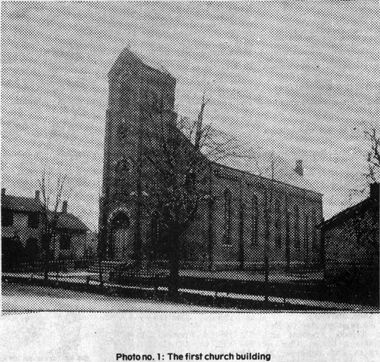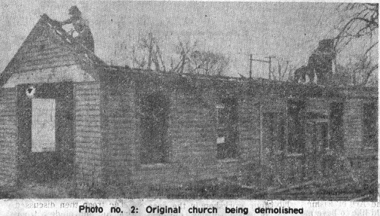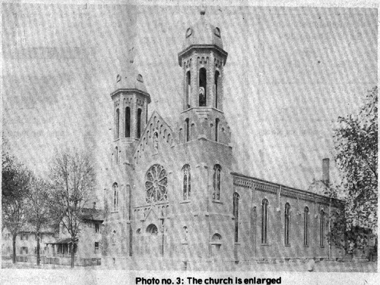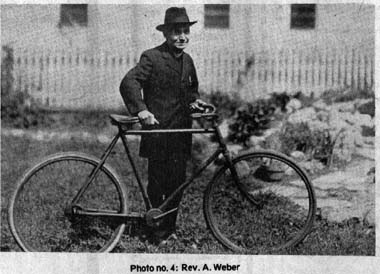April 9, 1981




Picture #1 – The first church building
Picture #2 – Original church being demolished
Picture #3 – The church is enlarged
Picture #4 – Rev. A. Weber
Author’s Note: This article about St. Wendelin, Fostoria’s second oldest church, was scheduled for publication earlier this year, but rescheduled because the Presbyterian Church, the city’s third oldest, was observing their 125th anniversary at that time with special events.
In 1843, before the formation of Fostoria, followers of the Catholic faith had already settled in the village of Rome. James McDonel, the grandfather of Lenore McDonel, is credited with being the first Catholic in this area. It was in McDonel’s log cabin on West Tiffin Street, just west of Main, that the first Mass was conducted in 1844 by Rev. Tiffin. He continued until 1849, being succeeded by the Sanguist Fathers from New Riegel.
Lenore McDonel, well-known in Fostoria as a business and community leader, was a resident of Edgewood Manor for a number of years, and was still living when this article was being prepared, but has since died.
Charles Foster, one of the early settlers of Rome, after whom Fostoria was named, donated one acre of land to the small group of Catholics for construction of a church. The land is the same location of the present church, rectory and elementary school on North Wood Street. However, until 1851, when a church was built at that site, church services were held in the home of Nicholas Portz Sr., conducted by the Sanguist Fathers.
Portz was a leading businessman and industrialist during the early days of Fostoria, and a close friend and business associate of Charles Foster.
FIRST CHURCH 1851
During the pastorate of Father Gales, the construction of the first church was begun in 1849, but because of the poverty among the congregation, the church was not completed until 1851. It was a very unpretentious frame building 30 to 40 feet, with a humble alter and primitive furnishings, according to historical notes. The pews were planks with wooden pegs for legs.
That original structure servied the small congregation for 28 years, and then in 1885, during the pastorate of Father Dechant, it was enlarged. That first church can be seen in the extreme right of Photo No. 1. That photo also shows the brick church which replaced it many years later.
Photo No. 2 shows the original church when it was being demolished in 1953 to make way for the highway underpass. That building was also St. Wendelin’s first school from 1873 to 1904. At that latter date it was moved to the rear of the property owned by Nicholas Portz on West Fremont Street, west of where the Mann-Hare Funeral Home is now. It was later sold to Dr. and Mrs. Pelton and moved to West South Street, where it was used as a garage and workshop until it was demolished.
In about 1851, St. Wendelin was chosen as the patron of the church. The church’s historical data indicates that St. Wendelin was chosen as its name because some of the people in the local congregation had come from the town of St. Wendel in the Saar district of Germany.
In 1859, the local church came under the jurisdiction of the Findlay Church for a period of 10 years and was served by four priests: Rev. J.H. Rotzer until March 1863; Rev. H. Behrams until July 1863; Rev. M. Dechant until June 1867; Rev. E.J. Vottmann until April 1869.
FIRST RECTORY 1870
Rev. Michael Pultz was appointed the first resident pastor in October 1870, but when he was transferred to another church, St. Wendelin again became a mission church under Findlay. It was during Putz’s term that the first rectory was built. It was a frame building which cost $1,500 and is shown in the left and next to the church in Photos No. 1 and 3. It had a belfrey, and it may be concluded that it housed the only bell that was available to summon worshippers to church services.
New life came to St. Wendelin in 1875, when it became an independent parish, and Father Arnoldi became the resident pastor, remaining until May 1886.
The present brick church was started under Arnoldi supervision, and the cornerstone was set July 6, 1879, by Bishop Gilmour. The first Mass was said in Dec. 21, 1879, even though the interior was not completed. It was necessary to start using the building because the original church was in such sad state of dilapidation. It was July 2, 1882, before the church was completed and dedicated. The cost was $10,000 exclusive of alter, pews and stained glass windows.
NEW CHURCH IN 1903
It should be mentioned that the church of 1882 is different in appearance from today’s church. It was not until 1903 that the two towers of today’s church were completed. One photo accompanying this article shows just one tower and it may be that it was erected in 1890, when the church was enlarged to meet the needs of the growing congregation, during Father Joseph Gloden’s pastorate. One historical note in church records indicates that in 1903, during Father G.H. Ricken’s pastorate, the church was enlarged and both towers were then in place. Photo No. 3 shows it then. In the left is the rectory. At that time a wooden fence surrounded the property.
Other pastors after Gloden were: Rev. Charles Griss, 1891-1899; Rev. Shunk for a short time until Father Kleekamp became pastor, remaining until 1901; when Father Rickens arrived to stay nearly three years.
1904 could well be described as a new era at St. Wendelin, when Rev. Ambrose Weber arrived to be new pastor. He had the longest tenure of any…37 years, and during that time much was accomplished, including the building of a new elementary school, high school, convent and new rectory.
WEBER REMEMBERED
Many living Fostorians will remember Father Weber for a variety of reasons from a religious standpoint, as well as for the chainless bicycle which he rode about town, attending the parishioners. It is shown with Weber in Photo No. 4. He brought the bicycle with him when he came to Fostoria. He had it during the early days of his priesthood at Warren. At that time, caring for 17 missions, he would start out early in the week with his kit fastened on his back and would travel on the bicycle for many days.
During Father Weber’s pastorate at St. Wendelin, he was credited with baptizing 1,714; celebrated 425 Nuptial High Masses and 665 funeral masses.
In 1907, the first assistant priest was sent to serve under Father Weber, and before he died Aug. 22, 1941, at age 88, there had been 21 young priests who had assisted him.
After Father Weber’s death, Rev. Raymond Osterhage administered in the interim until Rev. Raymonf Kirsch arrived to take over in July of 1942. Kirsch died Dec. 4, 1952. He had been president of DeSales College, Toledo, before coming here.
EXPANSION YEARS
During 1942-1952, the church was redecorated, the elementary school and rectory were enlarged, and property was acquired for future expansion.
Father Robert Ruffing followed Kirsch in Jan. 1953, with associated Rev. Donald Hunter, Rev. David VanHorn, and Rev. Cleo Schmenk. Ruffing stayed until 1959, when he was replaced by Father Louis Walter, who continued until his death in 1965.
Msgr. Clarence Yeager became pastor May. 7, 1965, continuing until Sept. 8, 1967, when Rt. Rev. Msgr. Leo Griffin became pastor holding the pastorate until April 7, 1972.
Since then St. Wendelin has been pastored by Rev. Ralph Reichert, 1972-74; Rev. Emery Ignacz, 1974 until May 1979; followed by Father Raymond Sheperd, presently in charge.